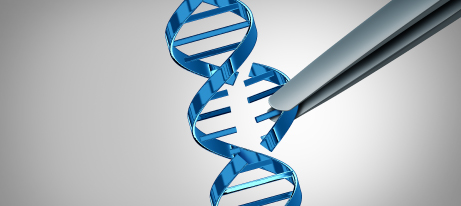
wildpixel / iStock
Developers of “prime editing,” a method that leverages RNA to directly “write” human cells into a specific DNA site, believe it has the ability to correct nearly 90% of all known disease-causing genetic variants. In the journal Nature, researchers describe how they used this genomic editing approach to correct with high precision and few byproducts the primary genetic causes of Tay-Sachs and sickle cell disease.
Both CRISPR-Cas9 and base editors—popular gene editing tools that have made headway in altering genomes to correct DNA and help prevent disease—have certain limitations. CRISPR-Cas9 acts like molecular scissors, making double-stranded cuts in DNA. While useful for disrupting genes and moving large segments of DNA, making precise changes with this approach has proven difficult, senior study author David Liu, PhD, director of the Merkin Institute of Transformative Technologies in Healthcare at the Broad Institute of MIT and Harvard, told CLN Stat.
“The methods to [make precise changes] such as homology-directed repair unfortunately do not work efficiently in most cells, and most of the outcomes still contain the uncontrollable mixtures, deletions, and insertions that follow DNA cutting,” Liu explained. Base editing, a method conceived in Liu’s lab, act as pencils, directly converting one DNA letter into another letter without making double-stranded breaks. The method can correct four of the most common types of point mutations while avoiding the byproducts that result from DNA cutting. What it can’t do is make the other eight possible types of point mutations, or the types of precise insertions or deletions needed to fix extra or missing DNA letters that cause diseases such as Tay-Sachs or cystic fibrosis, Liu said.
In contrast, prime editing does not make double-stranded breaks. “If CRISPR-Cas9 and other programmable nucleases are like scissors, and base editors are like pencils, then prime editors are like word processors, capable of searching for target DNA sequences and precisely replacing them with edited DNA sequences,” Liu said. The method incorporates one engineered protein and one engineered RNA to create a series of DNA targeting, writing, and repair steps that result in the “edit,” he indicated. Essentially, the method fuses a disabled Cas9 enzyme with a second enzyme called a reverse transcriptase, programmed with a prime editor guide RNA (pegRNA). This engineered guide RNA specifies the target DNA site and additionally, encodes the desired edit.
In the study, Liu and his team used prime editors to conduct more than 175 edits in human cells, including more than 100 point mutations of all 12 possible types, precise insertions up to 44 DNA letters in length, and precise deletions of up to 80 DNA letters. “The key to prime editing’s versatility is that the part of the pegRNA that specifies the edited DNA sequence can be virtually any sequence,” Liu stated.
Through this method Liu and his colleagues were able to correct the mutation that causes sickle cell anemia. This involved converting a specific T in HBB to an A in the normal gene sequence. They also corrected the mutation for Tay-Sachs by precisely removing the four-base insertion that causes the disease.
In both cases, “we corrected these mutations back to the normal DNA sequences efficiently (in about 55% and 35% of all the treated cells, respectively) while generating very few other products (about 1-2% of treated cells in these two cases),” Liu reported.
The scientists also used prime editing to install a protective G-to-T change in the human prion protein gene, a mutation that protects against prion disease in both humans and mouse models. “We have successfully tested prime editing in four different human cell lines, as well as in primary mouse cortical neurons, which can be challenging to edit because they are nondividing cells,” Liu said.
In his view, this first report of prime editing marks a long-standing aspiration to make any DNA change in any position of a living cell or organism, including human patients with genetic diseases. “Much more work is needed to fully realize this goal, including additional studies to characterize potential effects of prime editors in cells, to maximize their compatibility with additional cell types, and to interface viral and nonviral delivery methods to enable prime editing in live animals,” Liu said.